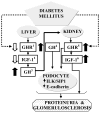The glomerular podocyte as a target of growth hormone action: implications for the pathogenesis of diabetic nephropathy
- PMID: 21067510
- PMCID: PMC4007067
- DOI: 10.2174/157339911794273900
The glomerular podocyte as a target of growth hormone action: implications for the pathogenesis of diabetic nephropathy
Abstract
Involvement of the growth hormone (GH) / insulin-like growth factor 1 (IGF-I) axis in the pathogenesis of diabetic nephropathy (DN) is strongly suggested by studies investigating the impact of GH excess and deficiency on renal structure and function. GH excess in both the human (acromegaly) and in transgenic animal models is characterized by significant structural and functional changes in the kidney. In the human a direct relationship has been noted between the activity of the GH/IGF-1 axis and renal hypertrophy, microalbuminuria, and glomerulosclerosis. Conversely, states of GH deficiency or deficiency or inhibition of GH receptor (GHR) activity confer a protective effect against DN. The glomerular podocyte plays a central and critical role in the structural and functional integrity of the glomerular filtration barrier and maintenance of normal renal function. Recent studies have revealed that the glomerular podocyte is a target of GH action and that GH's actions on the podocyte could be detrimental to the structure and function of the podocyte. These results provide a novel mechanism for GH's role in the pathogenesis of DN and offer the possibility of targeting the GH/IGF-1 axis for the prevention and treatment of DN.
Figures

Similar articles
-
Growth hormone (GH)-dependent expression of a natural antisense transcript induces zinc finger E-box-binding homeobox 2 (ZEB2) in the glomerular podocyte: a novel action of gh with implications for the pathogenesis of diabetic nephropathy.J Biol Chem. 2010 Oct 8;285(41):31148-56. doi: 10.1074/jbc.M110.132332. Epub 2010 Aug 3. J Biol Chem. 2010. PMID: 20682777 Free PMC article.
-
Identification of the glomerular podocyte as a target for growth hormone action.Endocrinology. 2007 May;148(5):2045-55. doi: 10.1210/en.2006-1285. Epub 2007 Feb 1. Endocrinology. 2007. PMID: 17272398
-
Intraglomerular crosstalk elaborately regulates podocyte injury and repair in diabetic patients: insights from a 3D multiscale modeling study.Oncotarget. 2016 Nov 8;7(45):73130-73146. doi: 10.18632/oncotarget.12233. Oncotarget. 2016. PMID: 27683034 Free PMC article.
-
Growth hormone and chronic kidney disease.Curr Opin Nephrol Hypertens. 2019 Jan;28(1):10-15. doi: 10.1097/MNH.0000000000000468. Curr Opin Nephrol Hypertens. 2019. PMID: 30394899 Review.
-
Impact of growth hormone hypersecretion on the adult human kidney.Ann Endocrinol (Paris). 2011 Dec;72(6):485-95. doi: 10.1016/j.ando.2011.08.001. Epub 2011 Nov 17. Ann Endocrinol (Paris). 2011. PMID: 22098791 Review.
Cited by
-
Notoginsenoside R1 ameliorates podocyte injury in rats with diabetic nephropathy by activating the PI3K/Akt signaling pathway.Int J Mol Med. 2016 Oct;38(4):1179-89. doi: 10.3892/ijmm.2016.2713. Epub 2016 Aug 24. Int J Mol Med. 2016. PMID: 27571993 Free PMC article.
-
Metabolic syndrome and associated chronic kidney diseases: nutritional interventions.Rev Endocr Metab Disord. 2013 Sep;14(3):273-86. doi: 10.1007/s11154-013-9268-2. Rev Endocr Metab Disord. 2013. PMID: 24036690 Review.
-
The effects of growth hormone on therapy resistance in cancer.Cancer Drug Resist. 2019 Summer;2(3):827-846. doi: 10.20517/cdr.2019.27. Epub 2019 Sep 19. Cancer Drug Resist. 2019. PMID: 32382711 Free PMC article.
-
Divergent roles of Smad3 and PI3-kinase in murine adriamycin nephropathy indicate distinct mechanisms of proteinuria and fibrogenesis.Kidney Int. 2012 Sep;82(5):525-36. doi: 10.1038/ki.2012.139. Epub 2012 Apr 25. Kidney Int. 2012. PMID: 22534961 Free PMC article.
-
Growth hormone induces Notch1 signaling in podocytes and contributes to proteinuria in diabetic nephropathy.J Biol Chem. 2019 Nov 1;294(44):16109-16122. doi: 10.1074/jbc.RA119.008966. Epub 2019 Sep 11. J Biol Chem. 2019. PMID: 31511328 Free PMC article.
References
-
- Moller N, Jorgensen JO. Effects of growth hormone on glucose, lipid, and protein metabolism in human subjects. Endocr Rev. 2009;30:152–77. - PubMed
-
- Baumann G. Growth hormone binding protein 2001. J Pediatr Endocrinol Metab. 2001;14:355–75. - PubMed
-
- Smith JR, Benghuzzi H, Tucci M, et al. The effects of growth hormone and insulin-like growth factor on the proliferation rate and morphology of RAW 264. 7 macrophages. Biomed Sci Instrum. 2000;36:111–6. - PubMed
Publication types
MeSH terms
Substances
Grants and funding
LinkOut - more resources
Full Text Sources
Other Literature Sources
Medical

